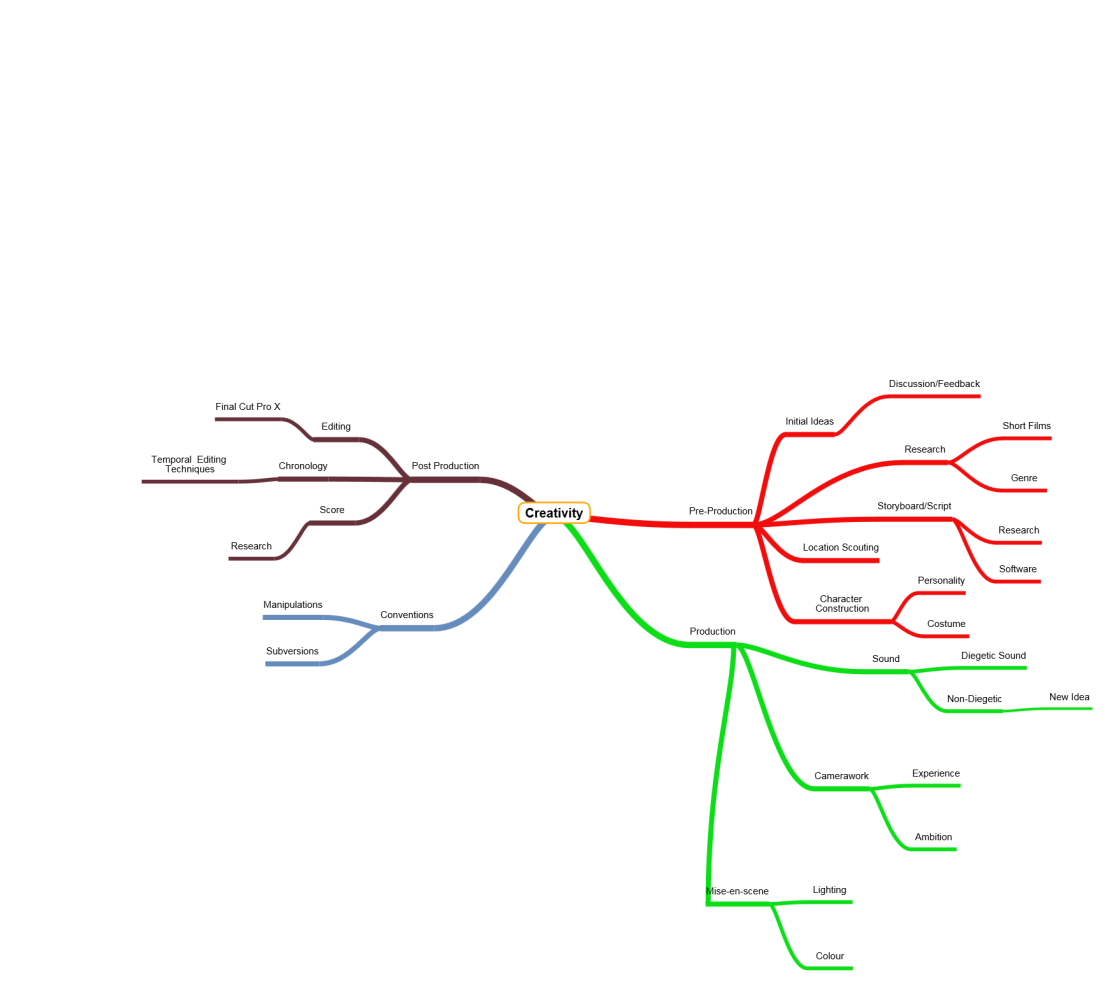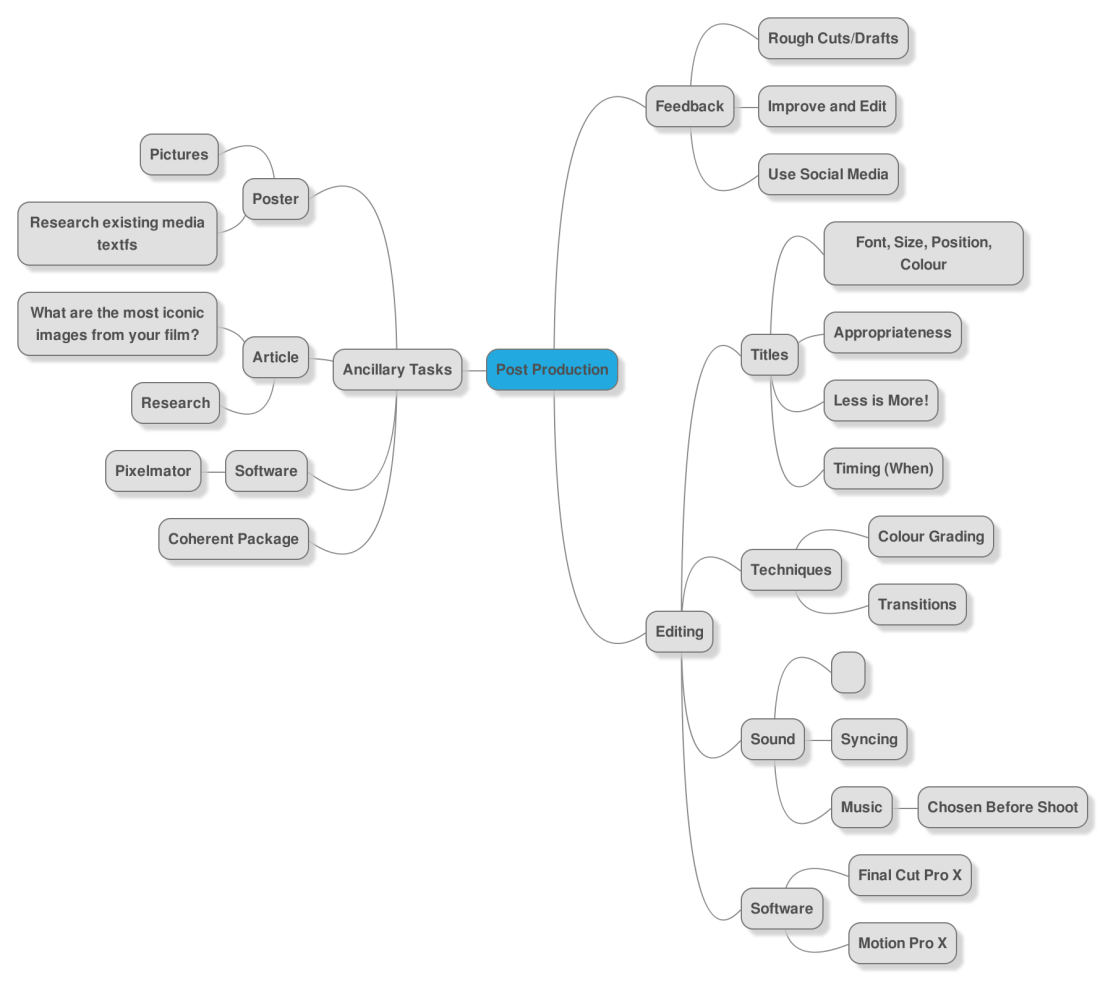Genre:
- A2- Horror therefore researched conventions of this genre in terms of setting (hotel) and costume (suit). Gained feedback about locations to narrow it down. Colour graded to fit feel of horror genre.
- AS- thriller therefore researched what shots should be used, lots of long ‘cold’ shots.
Form:
- AS- Idents feature in large films which we researched by looking at real media texts such as Se7en and Trainspotting. Looked at length and complexity of idents- eg universal. Also placed our title at the 2 minute mark as several films feature a short piece of film and then the title.
- A2- research of short films- don’t usually feature idents, often have few credits and rarely the title, however I did feature my title as I felt it was right.
Editing Conventions:
-
- Found music before filming at A2 as many short films do this in order to film to the music as it increases the chance of getting the right shots. When it came to editing it was much easier to edit to the pace of the music as it was pre-planned.
- At AS I didn’t do this which resulted in a more strenuous task of editing to the music and having to change the lengths of shots more than I wanted to.
Symbolism:
- A2- Use of costume to convey realism, dressing gown in the night scene and suit when he is arriving rather than AS where costume was very basic and casual, more carefully researched for A2 film- looked at the shining.
- Colour grading used at A2 more than AS as when researching horrors such as Insidious, the colours were very blue and cold so I replicated this feeling using the effect ‘Cold Steel’
- Use of appropriate location as a form of symbolism as the hotel is very Victorian symbolising an old, spooky setting.
- Less of this in AS however I did research how different shots could symbolise different things such as filming dark, cold and barren landscapes to convey isolation and loneliness of the girl in film opening GORDIAN.
Representation:
- Researched very little in terms of representation for AS as there was only one shot with a character in it, despite this I was able to represent their loneliness through the use of empty landscapes.
- Representation of gender was somewhat researched in my A2 as the only characters were male and the main character, Mr Walker who is staying next to the noisy room, is scared by the noises he hears and becomes deeply confused and venerable. Although some horrors show the man as being strong and confident, I chose to take from examples where the main character is the most threatened such as Scott Derricksen’s Sinister (2012) which allowed me to represent the man in a different light to most horror films.
Explain the most significant ways in which your media productions were informed by your understanding of the conventions of real media texts. Refer to a range of examples in your answer to demonstrate how this understanding developed over time.
My media productions have been heavily informed by conventions of real media texts such as the intensive research done on genre during my A2 coursework. The task was to produce a short film and so I decided to create a horror, I therefore began to research the stereotypes and conventions associated with this genre in order to make a media product that was as entertaining and professional as possible. My A2 media production ‘Disquiet’ was heavily influenced by Stanley Kubrick’s ‘The Shining’ as it was too set in a hotel that had a certain feel about it that i wanted to replicate in my own film. I therefore began to look at several hotels and found The Petwood hotel which is very victorian and fit with the genre my film was being moulded to. I also looked at the themes that horror films had and found that nightmares, the supernatural and religion were all rife in this genre as I looked at films such as Insidious. I decided to settle upon the idea of the supernatural as it was the most prominent genre feature. My understanding of conventions of real media texts has developed over time as in my AS coursework where I made a film opening which was relatively absent of dialogue and events and therefore there was less research to be done on conventions, however I did try to research the shots that were used in thrillers, as my film opening to ‘Gordian’ was of that genre.
I took a large amount of inspiration from films such as Close Encounters of the Third Kind as it features supernatural tendencies which I wanted to replicate in my own film. I originally wanted to make my film much more like Close Encounters of the Third Kind however I was not able to as the equipment needed, such as lights, was not available. I also took inspiration from the opening sequence of Se7en as it is very unnerving and uncomfortable by the use of dark images and disturbing noises. I therefore made a scene with a man being disturbed by loud noises, which is also how I got the name Disquiet for my film.
The form of my films through AS and A2 changed dramatically as my understanding developed. At A2 i paid some attention to form in terms of how films that are large features often have idents of the film companies, therefore using Motion X I created two idents, which was the common by looking at popular films such as Se7en and Hot Fuzz, for production companies ‘Framework Films’ and ‘Treeline Media’. I also found that depending on the importance and prominence of the production company in society, the length of the idents would change as Universal has a long and loud ident at the beginning of Hot Fuzz. I believed that this was not appropriate for my newly created film companies and so opted for silent and short dents. My understanding grew at A2 as I paid carefully attention to short films such as ‘Identity’ which, due to it being a short film, did not have any Idents and so I replicated this in my own work. The credits were also only shown at the end of the film, which once again influenced my own film.
Although there are many genre conventions to consider when looking at real media texts I started to look closer at the editing conventions when it came to A2. I found that many short films find the music before filming so that they can shoot, understanding the tempo of the music and fitting their shots to this. I therefore decided to use this method and it was incredibly useful as I was able to find better shots just by thinking about the music and for any crescendos in the track I would try to find bold and striking images that I would later cross dissolved to for a greater effect than if I found the music afterwards. In AS I found music after the shoot of my film opening which meant that I had to search for hours looking for the right music to fit my film. Other editing techniques such as colour grading were rarely used during my AS coursework, however I began to use them during the editing of my short film “Final Notice” for the LAFTAs, which is an award show to celebrate youth filmmakers in Lincolnshire. I used the colour correction software on Final Cut Pro X to convey the sadness of the death of the main character as the place at which I filmed was very neutral and so I wanted the film to appear colder towards its end. During my A2 coursework however, I looked at films such as Insidious which was very blue and cold in colour which I chose to replicate in my own film ‘Disquiet’ by the use of the colour correction tool ‘Cold Steel’ which conveyed a more horror-like feel associated with other real media texts of the same genre.
I researched very little in terms of representation conventions in real media texts during the production of my AS film opening, Gordian, as there was only a single shot with a character in it, however despite this I was able to represent the characters loneliness through the use of several shots of a cold, barren landscape. Representation of roles within horror films was however researched during my A2 coursework as there is usually a main male character, such as Ellison Oswald in Scott Derrickson’s Sinister (2012), and so my film was informed by this media text as I too had a male main character in the form of Mr. Walker. I further took inspiration from Sinister as the usual dominant male character is not featured in this film, rather a man being scared and tormented by the events in his house. I therefore made my character appear scared by the noises from the room next door to show an atypical view of men in horror films.



